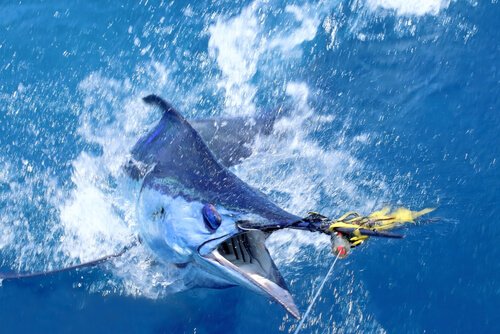Swordfish, characteristics and curiosities
The Xiphias gladius , commonly known as swordfish, gladiator, emperor, swordfish or broadsword, is one of the largest fish that exist. A swordfish can measure from three to five meters in length and weigh between 300 and 635 kilograms .
Characteristics of the swordfish
In this species there is a marked sexual dimorphism. The swordfish is one of the few cases in which the females are much larger than the males. The latter rarely exceed 135 kilograms. On the other hand, the females reach maturity at four or five years of age, while the males reach it at three or four years.
The swordfish is one of the few fish they lose their scales and teeth as they reach maturity. The shape of their body is cylindrical, stylized and narrower towards the tip. It presents dark colors in the upper part, and light brown or gray in the ventral area. They have a very distinctive mouth, long and pointed: the shape of its mouth gives it its name, because it is very similar to a sword.
This animal is ectothermal, which means that it depends on the environmental temperature to get your body heat. However, it is also homeotherm, which means that it can regulate its own temperature.
A swordfish can be maintained at about 10 or 15 degrees Celsius above the water temperature at which it is heated. move Also, it has some glands next to his eyes that he uses to warm them up. These glands also warm your brains and allow you to have excellent vision in icy waters.
Feeding and habitat
Due to the shape of its beak, it has the ability to swim extremely fast, which, together with its considerable size, makes it a very effective predator . It is one of the most famous fish that exist for its incredible speed.

The swordfish is a carnivorous animal that usually rises to the surface to feed at night . It chases its prey and uses its beak to distract, stun and capture them. As it has no teeth, it can cut its prey into pieces or swallow it whole. Among their favorite foods are squid, crustaceans, herring and hake.
It is a mostly solitary fish that is not grouped in schools and is usually about 10 meters from other swordfish He likes to climb to the surface showing his dorsal fin for 'sunbathing' and also to make impressive jumps off the sea surface.
Swordfish can be distributed in virtually all the world's oceans, but prefer those that are tropical or subtropical. However, it is possible to find them in cold water, provided that the water temperature does not exceed 22 degrees centigrade.
They usually move to a depth of 800 meters from the surface, because there the temperature oscillates around 15 degrees centigrade . They tend to concentrate where important marine currents are found and their migrations are vertical; follow the movements of shrimp, squid and other fish, and travel to cooler regions to feed during the summer.
Swordfish reproduction
Male swordfish reach sexual maturity when they measure 100 centimeters. On the other hand, females reach it when they reach 150 centimeters.A female can carry between 1 and 29 million eggs in her gonads.
Eggs measure between 1.6 and 1.8 millimeters in diameter . From the moment of fertilization, the embryonic development ends in approximately two and a half days. Small larvae of just four millimeters long, with a long snout, emerge from the eggs. These larvae live very close to the surface, because they need the heat of the sun.
As the larva grows, its body becomes thinner and stylized, and when it reaches 12 millimeters the beak is already considerably developed compared to the still tiny size of the body . As the animal develops, the top of the beak grows proportionally faster than the bottom.
When the fish is about 23 centimeters, it has a dorsal fin that extends throughout the length of the body . As it grows, however, that dorsal fin develops a single lobe. When the fish reaches 52 centimeters, its second dorsal fin has already developed .
Swordfish predators
An adult swordfish has few natural predators, because not many can compete with him in speed, strength and size . Therefore, only orcas and sharks dare to contemplate it as part of their diet.
But this does not mean that they are out of danger. The human being is the greatest predator of this extraordinary fish . Whether commercial or sports, overfishing has caused populations in some areas to be drastically reduced. It's time to raise awareness before it's too late and the swordfish disappears forever.


